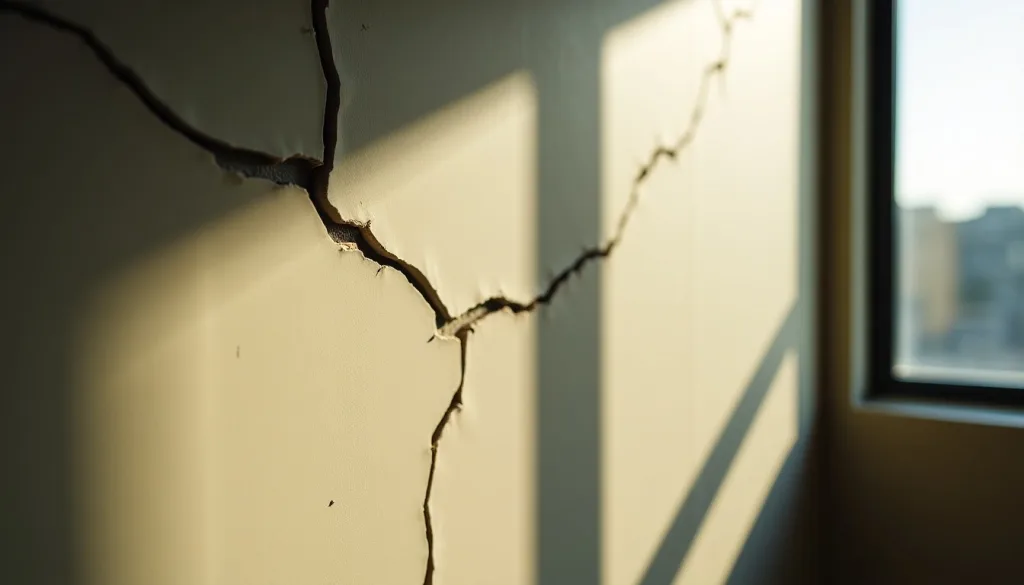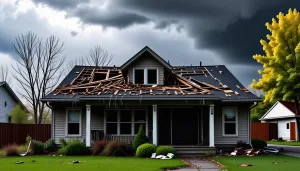Identifying common signs of foundation issues early on is pivotal to maintaining the structural integrity of your home and avoiding more extensive and costly repairs in the future. Homeowners should remain vigilant for various indicators that may suggest underlying foundation problems. By recognizing these signs promptly, you can address potential issues before they escalate, ensuring your home remains safe and stable.
One of the most apparent signs of foundation issues is the appearance of cracks. You’ll want to pay attention to:
- Vertical or Diagonal Cracks: These are often found in the walls, especially near windows, doors, or corners of the building. While some hairline cracks may be harmless, wider cracks could indicate significant foundation movement.
- Horizontal Cracks: These can be more serious, hinting at pressure against basement walls, which might compromise structural integrity. Immediate evaluation by a professional is recommended.
Another common indicator of potential foundation problems is uneven or sloping floors. A noticeable slope or general unevenness in the flooring throughout your home can be a red flag. This might be due to settling of the foundation or shifts in the underlying soil. Aligning with this, you might notice doors and windows that are difficult to open or close properly. Frames could be out of alignment due to the foundation shifting, which could also lead to gaps between doors, windows, and their respective frames.
Look out for gaps or separation in the structure of your home. For instance, gaps between the walls and ceilings or floors can signal that parts of your home are pulling away from each other as the foundation shifts. Mortar joints could also appear separated, or bricks might show signs of cracking.
Exterior signs can also be indicative. You might observe the following around your home’s perimeter:
- Sloping or Cracking in Driveways or Patios: Concrete surfaces can shift along with the foundation, leading to cracks and uneven areas.
- Separating Chimneys: A chimney that leans away from the structure suggests foundational movement.
Regular inspection and attention to these signs can help prevent further damage. If you notice any of these warning signs, it’s crucial to consult a foundation repair specialist who can provide a detailed assessment and propose the appropriate course of action.
| Sign | Possible Cause | Suggested Action |
| Vertical or Diagonal Cracks | Minor settling or significant foundation movement | Monitor small cracks, consult a professional for wide cracks |
| Horizontal Cracks | Pressure against basement walls | Immediate professional evaluation |
| Uneven or Sloping Floors | Foundation settling or soil movement | Professional inspection to assess underlying damage |
| Gaps or Separation in Structure | Foundation shifting | Consult a structural engineer |
| Separating Chimneys | Foundation movement | Immediate inspection required |
Addressing these issues early helps prevent more extensive foundation destabilization, ensuring your home remains safe and your repair costs are kept in check.
Factors affecting repair costs
When it comes to foundation repair costs, several key factors can dramatically influence the final pricing of your home repairs. Understanding these elements will help you better anticipate the financial commitment required to restore your home’s structural integrity. Here’s a close look at the primary factors affecting foundation repair costs:
- Extent of Damage:
The degree of foundation damage is a major determinant of repair costs. Minor cracks or negligible settling typically require less work and, therefore, lower costs. However, substantial damage, like extensive foundation movement or severe cracking, will entail more comprehensive repairs and higher expenses.
- Foundation Type:
The type of foundation your home has will also affect repair costs. Slab foundations might cost less to repair compared to more complex structures, such as basements or crawl spaces, which might require more labor-intensive methods and materials.
- Soil Conditions:
The soil under and around your home can significantly impact repair costs. If the soil is unstable, such as clay that expands and contracts with moisture changes, additional stabilization methods will be needed, increasing costs. Moreover, poor drainage that exacerbates soil instability may require costly correction.
- Location and Accessibility:
Homes located in hard-to-reach areas might incur higher costs due to the complexity and equipment needed to access the foundation for repair. Urban homes with restricted access may require specialized machinery, further impacting costs.
- Repair Method:
The chosen repair method can influence overall costs. Common methods include underpinning, mudjacking, or the use of hydraulic piers, with each method varying in cost based on the technology and labor involved. For instance, installing piers can be more expensive than simpler methods like sealing cracks.
- Permit Requirements:
Some regions require permits for foundation repairs, and the cost of these permits can add to the overall expense. Additionally, meeting local building codes might require extra work to align with regulatory standards, increasing costs.
- Contractor Experience:
Experienced contractors may charge more for their services due to their expertise and quality of workmanship. While this might seem costly, engaging experienced professionals can often lead to better outcomes and potentially lower long-term costs, due to fewer repairs being needed in the future.
By understanding these factors, you can make informed decisions when seeking estimates and planning your budget for home repairs. An accurate assessment of these variables can prepare you financially, ensuring that costs related to restoring your home’s structural integrity are managed properly.
Types of foundation repairs
When addressing foundation repairs, there are several methods available, each suited to different types and severities of damage. Understanding the specific techniques used can equip homeowners with the knowledge needed to tackle foundation issues, while potentially easing some of the overwhelm associated with these necessary home repairs.
One widely used method is underpinning, which involves strengthening and stabilizing the foundation by extending it in depth or breadth. This is particularly beneficial for homes experiencing serious structural integrity issues due to unstable soil conditions. The process often involves adding additional support beneath the current foundation to distribute weight more evenly. Though potentially more costly, underpinning can provide long-term stability, making it a worthwhile investment when major foundational shifts are detected.
Another option is piering. This is a repair method that uses steel or concrete piles to support and stabilize the existing foundation. When the natural soil is unable to hold the weight of the house effectively, helical or push piers might be driven deep into the ground to stabilize it. This technique is especially effective in homes built on expansive soils or in regions with poor soil quality. It’s favored for its capability to offer a permanent solution to foundation settlement challenges.
Mudjacking is a more traditional approach used to address issues with sinking slabs. This method involves pumping a slurry of cement, sand, and other materials beneath the affected area to lift the slab back to its original position. Suitable for concrete slabs and walkways that have settled, this method is not only cost-effective but also minimally invasive, typically restoring function within a matter of hours.
For less severe issues, foam injection might be utilized. Similar to mudjacking, this technique uses a polyurethane foam to fill voids under sunken slabs. The foam expands, lifting the slab to the desired height. This method can be particularly appealing due to its rapid execution and minimal disturbance to the surrounding area.
When cracks are present but do not compromise the overall structural integrity of the home, simpler methods like epoxy injection may be sufficient. This technique involves injecting a high-strength epoxy into cracks to seal them and prevent moisture infiltration. Although effective for aesthetic concerns or minor cracking, it won’t address the root cause of structural shifts.
It’s important for homeowners to recognize that each repair method carries its own benefits and limitations, often depending on the specific nature and cause of the foundation issue. Consulting with a professional to determine the most suitable repair approach for your home is crucial. Expert advice ensures that choices are well-informed and that the investment made in restoring your home’s foundation is sound, ultimately preserving the value and safety of the property. Understanding these repair options provides peace of mind as you work towards safeguarding the structural integrity of your home.
Average cost breakdown
Understanding the various components of foundation repair costs can help you better plan and budget for these essential home repairs. While each case is unique and influenced by numerous factors, it’s possible to create an average cost breakdown to give you a clearer picture of what you might expect to spend to preserve your home’s structural integrity.
Typically, foundation repair costs can range widely, from as low as a few hundred dollars for minor repairs to several thousand dollars for more extensive work. One of the primary considerations is the cost per repair method. For instance, simple crack repairs might cost between $300 and $800, depending on the severity and accessibility of the area. These repairs often involve epoxy or polyurethane injections to seal cracks and prevent water infiltration. While relatively inexpensive, this approach does not solve underlying issues of foundation movement or instability.
For cases requiring more robust stabilizing measures, underpinning or pier installation is often necessary, which can significantly increase costs. Underpinning, which strengthens the existing foundation by extending its depth, can cost between $1,000 and $3,000 per pier needed, with an overall project average ranging from $5,000 to $15,000. Similarly, piering involves installing steel piers below the foundation and might range between $1,000 to $2,500 per pier, depending on the property’s specific needs and soil conditions.
Mudjacking offers a cost-effective solution for lifting sunken slabs, with average costs around $500 to $1,500 per job. This technique is highly suitable for driveways, sidewalks, and other concrete surfaces where subsidence is evident but doesn’t address the foundational root causes of shifts. More modern approaches like foam injection can range from $1,500 to $3,000, providing a slightly more expensive but effective alternative to traditional mudjacking.
Drainage correction and soil stabilization may also be necessary supplementary expenses, especially if poor drainage contributes to foundation issues. These may add another $2,000 to $6,000 to your total repair costs. Addressing the root causes of foundation issues, such as poor drainage or problematic soil conditions, is crucial to preventing recurring problems and maintaining long-term stability.
Labor costs, regional price differences, and permit fees can also contribute to the final pricing, with professional services and materials differing from one geographic area to another. Additionally, access to the foundation and any potential challenges with location can further complicate and increase expenses.
It’s vital for homeowners to obtain several quotes from reputable contractors to ensure fair pricing and adequate scope of work. Understanding the average breakdown of these costs not only aids in budgeting but also prepares you to manage the financial aspects of critical home repairs, ensuring your home’s value and supporting its structural integrity in the long run. Remember to conduct thorough research and consult experienced professionals to verify the necessity and extent of repairs suggested, safeguarding your investment in the property.
Tips for budgeting effectively
When confronting foundation repairs, effective budgeting is crucial to ensuring that you can address issues promptly without compromising your financial stability. Here are some strategies to help you effectively budget for these essential home repairs, preserving your home’s structural integrity.
First, it’s essential to approach budgeting with a combination of informed research and detailed planning. Begin by conducting a thorough assessment of your home’s foundation to understand the exact nature and urgency of the repairs needed. Engaging a professional for a formal inspection can offer insights into the severity of the problem and potential repair solutions, which will help you anticipate costs more accurately. Gaining a clear understanding of what needs to be fixed allows for a more precise financial plan.
Once you know the specific repairs needed, gather multiple quotes from reputable contractors. This will not only give you a sense of the range of prices in your area but also assist you in identifying a fair price for the repair work. Make sure to inquire about all potential costs, including labor, materials, and any permits required, which can vary depending on local regulations. Having a detailed breakdown of expenses allows you to evaluate and compare estimates effectively.
Consider setting aside a contingency fund within your budget. Foundation repair projects can sometimes encounter unexpected issues once work begins, potentially increasing the final costs. Allocating an additional 10-15% for unforeseen expenses can provide a buffer to absorb any surprises, ensuring the project can proceed without financial strain.
It’s also wise to explore financing options for your foundation repairs. Some contractors offer financing plans, which may alleviate the immediate burden on your budget by allowing you to pay for repairs over time. Alternatively, you might consider a home equity loan, provided the terms are favorable, as these repairs can significantly impact the value and safety of your home.
Regularly maintaining your foundation can mitigate the need for extensive repairs in the future. Simple tasks, such as managing drainage away from your home’s foundation and maintaining consistent soil moisture levels, can prevent conditions that lead to foundation damage. By investing in these preventive measures now, you can save substantial amounts on repairs over time.
By planning ahead, gathering accurate information, and considering all possible expenses and financing options, you can manage your foundation repair budget effectively. This strategic approach not only safeguards your finances but also ensures the long-term safety and structural integrity of your home.





